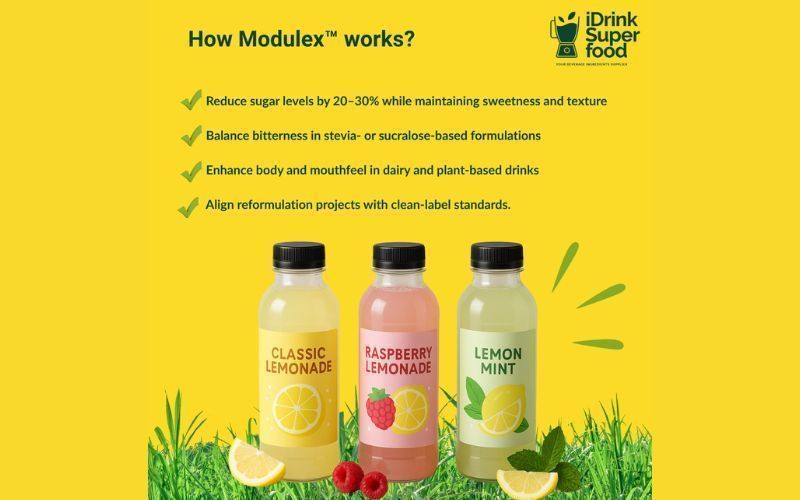Sweet Science: How Modulex™ Could Redefine Taste Modulation in the Era of Sugar Reduction
The global food industry stands at a crossroads. Health authorities and consumers alike are demanding products with less added sugar — yet the challenge remains the same: how do we make low-sugar foods taste as good as their full-sugar versions? For beverage and dairy producers, this balance between taste, nutrition, and market acceptance has become one of the most pressing innovation priorities of the decade.

Reducing sugar is not as simple as removing sucrose and replacing it with low-calorie alternatives
- To reduce sugar levels by 20–30% while maintaining sweetness and texture;
- To balance bitterness in stevia- or sucralose-based formulations;
- To enhance “body” and mouthfeel in dairy and plant-based drinks;
- To align reformulation projects with clean-label standards.
How to do this with Super Food FZCO
Recent research by The Product Makers in Australia in partnership with Super Food FZCO points to a promising natural solution, specifically formulations like Modulex™, which act not as sweeteners but as taste modulators. These plant-based extracts enhance sweetness perception, soften bitterness, and improve mouthfeel, helping manufacturers cut sugar levels without sacrificing flavor.Fr om Sweetener Substitution to Sensory Science
Reducing sugar is not as simple as removing sucrose and replacing it with low-calorie alternatives. Sugar plays multiple roles in product formulation: it provides sweetness, balances acidity, contributes to mouthfeel, and even influences color and preservation.
Artificial and natural high-intensity sweeteners such as aspartame or stevia deliver sweetness, but often with side effects — metallic notes, lingering aftertastes, or a thinner sensory experience. Consumers quickly notice these differences, and repeat purchases drop. In fact, surveys from Innova Market Insights (2024) show that over 60% of consumers want lower-sugar products — but only if the taste remains the same.
That’s wh ere Modulex™ stand out. Derived from Saccharum officinarum, these extracts retain some natural sugars and a wealth of polyphenols, amino acids, and minerals that engage multiple taste pathways. Instead of acting like a single sweetener molecule, they create a more complete, sugar-like sensory experience — a harmony of sweetness, body, and smoothness.
How Modulex™ Work
At the molecular level, the sweetness we perceive is triggered by receptors on the tongue, primarily T1R2/T1R3. Artificial sweeteners typically bind to just one part of this receptor complex, activating sweetness but leaving other sensory pathways untouched. Sugar cane extracts, by contrast, interact with several domains at once.
Their polyphenols and amino acids can allosterically enhance sweetness perception, while their mineral content (potassium, calcium, sodium) improves “mouth-coating” — that creamy, rounded sensation typical of natural sugar. They also activate the calcium-sensing receptor (CaSR), associated with what Japanese researchers call kokumi — the perception of richness and continuity in flavor.
This multimodal interaction doesn’t just add sweetness; it restores balance and depth to low-sugar formulations.
Taste in Practice: Evidence from Sensory Studies
In controlled sensory evaluations, Modulex™ demonstrated remarkable results across a range of beverage applications. When added at just 0.1% concentration to drinks sweetened with stevia or sucralose, it increased overall likeability scores by 15–20%.
In a peach tea formulation, participants rated the product with Modulex™ significantly higher on taste, noting a 20% reduction in metallic notes and a 17% improvement in body. A similar test on orange-flavored carbonated drinks yielded a 10% higher overall preference compared to the control sample.
Perhaps most importantly, these sensory improvements allowed formulators to reduce total sugar content by up to 30%, maintaining flavor satisfaction while cutting calories — a key advantage in markets facing sugar taxation and tightening health regulations.
Applications Beyond Beverages
While the beverage industry has been the fastest to adopt taste modulation, the potential of Modulex™ extends to dairy, confectionery, and bakery. In dairy drinks, for instance, they help restore creaminess and roundness that can be lost when reducing lactose or sucrose. In sauces or desserts, they balance acidity and bitterness, creating a smoother overall taste.
Because the extracts are derived from a familiar source — sugar cane — they align well with clean label and natural origin trends. Under many regulatory frameworks, they can be declared as “natural flavor” or “sugar cane extract,” avoiding the consumer skepticism that often surrounds chemical-sounding additives.
Consumer Trust and the Clean-Label Advantage
Consumer trust has become a strategic currency. According to NielsenIQ (2025), 67% of shoppers globally prefer food and drink brands that use “recognizable” ingredients. Sugar cane extracts benefit from this familiarity. They are perceived not as an artificial substitute, but as a natural extension of an ingredient people already know — sugar.
That perception is powerful. It bridges the gap between indulgence and health — helping consumers feel that they are not “giving up” taste, but rather upgrading to a smarter, more balanced choice.
Aligning with Policy and Market Dynamics
As the World Health Organization (WHO) continues to promote sugar reduction targets — and more than 50 countries now implement sugar taxes or front-of-pack labeling — manufacturers are under increasing pressure to reformulate.
Countries like Mexico, Chile, South Africa, and the UAE have already shown that fiscal measures drive meaningful reformulation, but only when technology allows it. Without ingredients that maintain taste, reduced-sugar products risk poor consumer acceptance.
That’s why Modulex™ matter: they serve as a bridge between regulatory ambition and commercial success. They help manufacturers meet policy-driven nutritional goals while keeping consumers engaged and loyal.
Toward the Next Generation of Sugar Reduction
The journey toward lower-sugar nutrition doesn’t have to mean sacrificing taste. With natural taste modulators like Modulex™, manufacturers can finally balance health, flavor, and consumer experience.
By capturing the complexity of real sugar in a plant-based form, these extracts make it possible to design products that are both compliant and craveable — aligning industry innovation with public health goals.
In the coming years, as global food systems continue to shift toward transparency and wellness, ingredients like Modulex™ could become essential tools in every formulator’s arsenal — not as a replacement for sugar, but as a catalyst for a better-tasting, healthier future.
Want to know more?
Meet iDrink Super Food team at Gulfood Manufacturing Hall Concourse 2 Stand CC7-8











